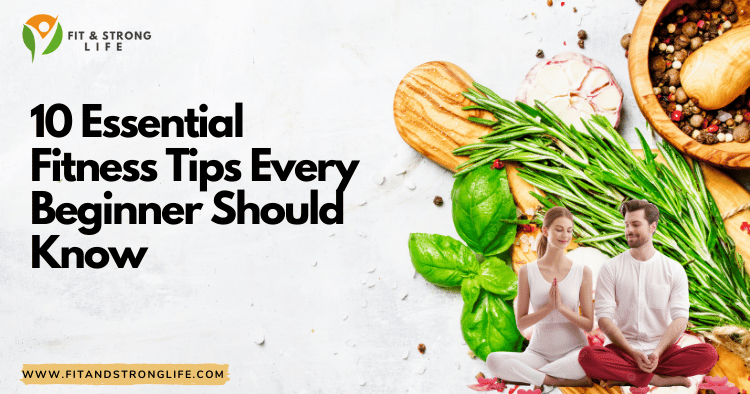10 Essential Fitness Terms Every Beginner Should Know
Welcome to the world of fitness! If you’re just starting out, you might be feeling a bit overwhelmed by all the jargon floating around. Don’t worry—this guide will break down ten essential fitness terms that every beginner should know. Understanding these terms will not only help you navigate your fitness journey but also make your workouts more effective and enjoyable.
Table of Contents
1. Cardio
What is Cardio?
Cardiovascular exercise, often referred to as cardio, is any exercise that raises your heart rate. This includes activities like running, cycling, swimming, and even brisk walking. Cardio is essential for heart health, improving endurance, and burning calories.
“Cardio is like the fuel for your fitness engine; it keeps everything running smoothly!”
Why is it Important?
Cardio workouts help strengthen your heart and lungs, making daily activities easier. Plus, they can enhance your mood by releasing endorphins, the body’s natural mood lifters.
FAQs:
- How often should I do cardio? Aim for at least 150 minutes of moderate-intensity cardio each week.
- Can I do cardio every day? Yes, but listen to your body and mix in lower-intensity sessions if needed.
2. Strength Training
What is Strength Training?
Strength training involves using resistance to build muscle strength and endurance. This can be done using free weights, resistance bands, or bodyweight exercises like push-ups and squats.
“Strength training is not just about lifting weights; it’s about lifting yourself to new heights!”
Why is it Important?
Strength training not only helps you build muscle but also improves bone density, boosts metabolism, and can enhance overall physical performance. For more on this, check out our article on 10 Essential Strength Training Tips for Beginners.
FAQs:
- How many times a week should I strength train? Aim for at least two days a week, focusing on different muscle groups.
- Can I gain muscle without weights? Absolutely! Bodyweight exercises can be very effective.
3. Reps and Sets
What are Reps and Sets?
“Reps” (short for repetitions) refer to the number of times you perform a specific exercise, while “sets” refer to the group of reps completed consecutively. For example, if you do 10 push-ups, that’s one set of 10 reps.
“Think of reps as the building blocks of your workout, and sets as the foundation!”
Why is it Important?
Understanding reps and sets helps you structure your workouts and track your progress effectively.
Example Table:
| Exercise | Reps | Sets |
|---|---|---|
| Push-Ups | 10 | 3 |
| Squats | 15 | 3 |
| Bicep Curls | 12 | 3 |
4. Muscle Groups
What are Muscle Groups?
Muscle groups refer to clusters of muscles that work together to perform specific movements. The major muscle groups include the chest, back, legs, arms, and core.
“Targeting muscle groups is like conducting an orchestra—each part plays a vital role in the harmony of your fitness journey.”
Why is it Important?
Targeting different muscle groups in your workouts allows for balanced strength development and helps prevent injury. For more details, see our guide on Top 10 Essential Vitamins and Minerals for Fitness Gains.
FAQs:
- How do I know which muscle group to work on? Consider your fitness goals—whether you want to build strength, improve endurance, or focus on aesthetics.
5. Flexibility
What is Flexibility?
Flexibility refers to the range of motion in your joints and muscles. Stretching exercises, yoga, and Pilates can help improve flexibility.
“Flexibility is the key to unlocking your body’s full potential; it helps you move with grace and ease!”
Why is it Important?
Improving flexibility can enhance your overall performance, reduce the risk of injury, and alleviate muscle soreness. For strategies to improve your fitness, check out our 10 Essential Mobility & Flexibility Exercises for Strength.
FAQs:
- How often should I stretch? Incorporate stretching into your routine at least 2-3 times per week.
6. Core
What is the Core?
The core consists of muscles in your abdomen, lower back, hips, and pelvis. These muscles are essential for stability and balance.
“A strong core is like a solid foundation for a house—everything else is built upon it!”
Why is it Important?
A strong core supports proper posture and enhances performance in almost every activity, from running to lifting. For effective core workouts, explore our 10 Effective Core Strengthening Workouts at Home.
FAQs:
- What are good core exercises? Planks, Russian twists, and leg raises are excellent choices.
7. BMI
What is BMI?
Body Mass Index (BMI) is a numerical value derived from your height and weight. It’s a useful tool for assessing whether you’re in a healthy weight range.
“BMI is like a quick health snapshot, but remember, it doesn’t capture the full picture of your well-being!”
Why is it Important?
While BMI isn’t a perfect measure of health, it can provide a general guideline for weight management.
FAQs:
- How do I calculate my BMI? Use this formula: BMI = weight (kg) / height (m)2. You can also use an online calculator for convenience.
8. HIIT
What is HIIT?
High-Intensity Interval Training (HIIT) involves alternating short bursts of intense exercise with periods of rest or lower-intensity exercise.
“HIIT is like a rollercoaster ride for your fitness—it gets your heart racing and burns calories in record time!”
Why is it Important?
HIIT is an efficient workout that can burn more calories in less time, improve cardiovascular health, and build strength. Beginners can check out Top 7 Effective Strength Training Routines for Beginners for guidance.
FAQs:
- Can beginners do HIIT? Yes! Start with shorter intervals and gradually increase intensity as you improve.
9. Rest Days
What are Rest Days?
Rest days are designated days where you allow your body to recover from workouts. This is crucial for muscle repair and growth.
“Rest days are like pit stops in a race—essential for refueling and recharging your body!”
Sure! Please provide me with the Markdown content that you would like to convert to HTML.Visited 1 times, 1 visit(s) today




